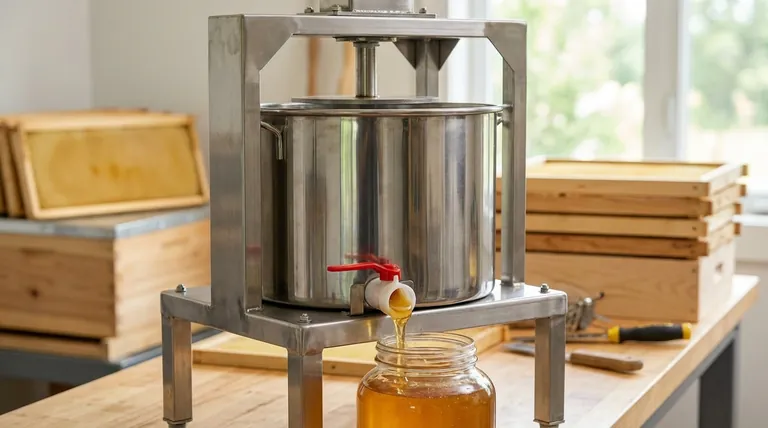The key features of a stainless steel honey press center on its material construction, operational control, and ability to maximize yield. A quality press is built from durable, food-grade stainless steel with solder-free welds to ensure honey purity, and includes features like variable pressure control and integrated filtering to produce clean honey efficiently from sources that centrifugal extractors cannot handle.
A stainless steel honey press is not just a tool for extraction; it is a specialized instrument designed to maximize honey yield and guarantee purity. Its value lies in its ability to reclaim honey from wax cappings and irregular comb, turning potential waste into a valuable product.

The Foundation: Food-Grade Stainless Steel Construction
The choice of material is the most critical feature of a high-quality honey press. It directly impacts durability, safety, and the final quality of your honey.
Uncompromising Durability and Longevity
A press made from high-quality, durable stainless steel is a long-term investment. This material is inherently rust-proof and robust, capable of withstanding the high pressures of extraction and the demands of a production environment without failing.
Ensuring Honey Purity
Stainless steel is non-reactive and does not have any paint or enamel coatings that can chip off into the honey. This prevents any unwanted chemicals or materials from leaching into your product, ensuring the honey's natural taste and purity are perfectly preserved.
The Importance of Solder-Free Welds
Superior models utilize TIG welding, which creates a seamless, solder-free bond. Solder can contain lead or other impurities, making solder-free construction a critical feature for anyone producing food-grade honey.
Maximizing Yield and Operational Efficiency
Beyond its construction, a honey press offers functional features that distinguish it from other extraction methods and help you get the most out of your harvest.
Processing Cappings and Burr Comb
Perhaps the most significant advantage is the ability to process uncappings, burr comb, and crushed comb. These honey-rich wax pieces cannot be processed in a centrifugal extractor, and a press allows you to reclaim this honey, significantly increasing your overall yield.
Variable Pressure Control
The ability to adjust pressure is crucial. Variable pressure control allows you to customize the force applied, depending on the wax's temperature and consistency. This ensures you extract the maximum amount of honey without unnecessary effort.
Integrated Filtering Systems
Many presses include a built-in filtering system, often a perforated basket or plate. This feature separates the liquid honey from the dry, pressed beeswax in a single step, producing clean honey that is ready for bottling with minimal secondary processing.
Understanding the Trade-offs
While powerful, a honey press is a specific tool with its own set of considerations. Understanding its limitations is key to making an informed decision.
Press vs. Centrifugal Extractor
The fundamental trade-off is comb preservation. A honey press crushes the comb to extract honey, meaning the beeswax must be rendered and the bees must rebuild new comb. In contrast, a centrifugal extractor keeps the comb intact for the bees to reuse, saving them significant energy.
Manual Effort and Batch Size
Most honey presses are manually operated and process smaller batches compared to large, motorized extractors. They are highly effective but can be more labor-intensive for very large-scale operations.
Portability and Storage
On the positive side, presses are often more compact and easier to store than their centrifugal counterparts, making them an excellent choice for beekeepers with limited space.
Making the Right Choice for Your Operation
Choosing the right equipment depends entirely on your beekeeping goals and the scale of your operation.
- If your primary focus is maximizing yield: A honey press is essential for reclaiming every last drop of honey from cappings and imperfect comb.
- If your primary focus is large-scale extraction from standard frames: A centrifugal extractor is likely the more efficient primary tool, with a press serving as a valuable secondary tool.
- If your primary focus is honey purity and equipment longevity: A high-quality stainless steel model of either a press or an extractor is the only choice.
Ultimately, a stainless steel honey press is an invaluable tool for the serious beekeeper dedicated to quality and efficiency.
Summary Table:
| Key Feature | Core Benefit |
|---|---|
| Food-Grade Stainless Steel | Ensures honey purity and long-term durability. |
| Solder-Free Welds | Prevents contamination, guaranteeing a food-safe product. |
| Variable Pressure Control | Maximizes honey extraction from cappings and comb. |
| Integrated Filtering | Separates honey from wax in one efficient step. |
Ready to maximize your honey yield and ensure product purity?
A high-quality stainless steel honey press is a critical investment for commercial apiaries and distributors focused on efficiency and quality. HONESTBEE supplies durable, food-grade beekeeping equipment designed for wholesale operations.
Contact our experts today to find the perfect honey press for your business needs and discover our full range of wholesale supplies.
Visual Guide

Related Products
- 10L Stainless Steel Electric Honey Press Machine
- HONESTBEE 8 Frame Electric and Manual Three Use Honey Extractor
- Easy Use Manual Stainless Steel Honey Press for Honey Comb
- Stainless Steel Honey Press Wax Press with Tank
- HONESTBEE 3-Frame Manual Acrylic Honey Extractor
People Also Ask
- What voltage options are available for stainless steel screw honey pumps? Choose the Right Power for Your Scale
- What are the benefits of using a honey press for Warré or Top Bar beehives? Maximize Your Natural Harvest
- What are the benefits of the screw design in a stainless steel honey pump? Preserve Honey Quality and Integrity
- What happens to the wax after pressing in a honey press? A Guide to Maximizing Your Hive's Yield
- How does the press method for extracting honey work? A Simple, Low-Cost Guide for Beekeepers



















